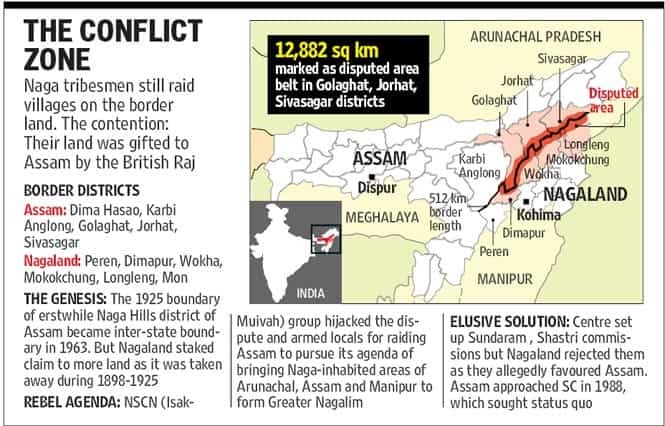Assam-Nagaland Border Dispute

- 08 Oct 2025
In News:
Tensions resurfaced along the Assam–Nagaland border after armed miscreants, allegedly from Nagaland, set fire to nearly 100 houses in a minority-dominated village within the disputed B Sector of Assam’s Golaghat district.
Background of the Dispute
- The Assam–Nagaland border dispute concerns overlapping territorial claims, particularly over forested tracts in Assam’s Golaghat, Jorhat, and Sivasagar districts, collectively known as the Disputed Area Belt (DAB).
- Since 1979, the Central Reserve Police Force (CRPF) has been deployed as a neutral force to maintain peace in these contested zones.
Historical Evolution
- Colonial Period (1826–1925):Following the Treaty of Yandabo (1826), the British annexed Assam and later established the Naga Hills District (1866). Subsequent boundary notifications redefined territories several times—often without consulting local Naga communities.
- Post-Independence Developments (1947–1963):The Nagas declared independence in 1947. Later, the Naga Hills–Tuensang Area Act (1957) and the State of Nagaland Act (1962) formalized Nagaland’s creation but did not define its boundary clearly with Assam, leaving scope for future disputes.
Commissions and Efforts at Resolution
Several commissions and agreements have attempted to resolve the dispute but failed to achieve a lasting solution:
- Sundaram Commission (1972): Led to four interim agreements maintaining the status quo.
- Shastri Commission (1985) and J.K. Pillai Commission (1997): Explored settlement options but faced rejection by one or both states.
- Variava and Chatterjee Commissions (2006): Submitted findings on boundary delineation, but implementation remained stalled.
Disputed Area Belt (DAB)
- The DAB covers forest land along the 512.1 km-long Assam–Nagaland boundary, primarily spanning Golaghat, Jorhat, Sivasagar, and KarbiAnglong districts of Assam.
- These forests were historically used by Naga tribes but fall within Assam’s constitutional limits.
Core of the Territorial Claims
- Assam’s Position:Assam upholds the constitutional boundary established when Nagaland was created in 1963, asserting that this demarcation is legally final.
- Nagaland’s Position:Nagaland bases its claim on historical and traditional Naga homelands, citing the 16-Point Agreement of 1960 and pre-colonial territorial arrangements. It seeks “restoration” of areas allegedly separated during British rule.
- Extent of Dispute:Assam accuses Nagaland of encroaching on over 60,000 hectares of land within the DAB.
